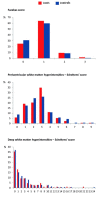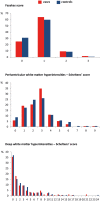Migraine with aura and risk of silent brain infarcts and white matter hyperintensities: an MRI study
- PMID: 27190013
- PMCID: PMC4939694
- DOI: 10.1093/brain/aww099
Migraine with aura and risk of silent brain infarcts and white matter hyperintensities: an MRI study
Abstract
A small number of population-based studies reported an association between migraine with aura and risk of silent brain infarcts and white matter hyperintensities in females. We investigated these relations in a population-based sample of female twins. We contacted female twins ages 30-60 years identified through the population-based Danish Twin Registry. Based on questionnaire responses, twins were invited to participate in a telephone-based interview conducted by physicians. Headache diagnoses were established according to the International Headache Society criteria. Cases with migraine with aura, their co-twins, and unrelated migraine-free twins (controls) were invited to a brain magnetic resonance imaging scan performed at a single centre. Brain scans were assessed for the presence of infarcts, and white matter hyperintensities (visual rating scales and volumetric analyses) blinded to headache diagnoses. Comparisons were based on 172 cases, 34 co-twins, and 139 control subjects. Compared with control subjects, cases did not differ with regard to frequency of silent brain infarcts (four cases versus one control), periventricular white matter hyperintensity scores [adjusted mean difference (95% confidence interval): -0.1 (-0.5 to 0.2)] or deep white matter hyperintensity scores [adjusted mean difference (95% confidence interval): 0.1 (-0.8 to 1.1)] assessed by Scheltens' scale. Cases had a slightly higher total white matter hyperintensity volume compared with controls [adjusted mean difference (95% confidence interval): 0.17 (-0.08 to 0.41) cm(3)] and a similar difference was present in analyses restricted to twin pairs discordant for migraine with aura [adjusted mean difference 0.21 (-0.20 to 0.63)], but these differences did not reach statistical significance. We found no evidence of an association between silent brain infarcts, white matter hyperintensities, and migraine with aura.
Keywords: cerebral infarction; cerebral ischaemia; headache: imaging; migraine; migraine with aura.
© The Author (2016). Published by Oxford University Press on behalf of the Guarantors of Brain.
Figures




Similar articles
-
Migraine with visual aura associated with thicker visual cortex.Brain. 2018 Mar 1;141(3):776-785. doi: 10.1093/brain/awx382. Brain. 2018. PMID: 29360944
-
Migraine, white matter hyperintensities, and subclinical brain infarction in a diverse community: the northern Manhattan study.Stroke. 2014 Jun;45(6):1830-2. doi: 10.1161/STROKEAHA.114.005447. Epub 2014 May 15. Stroke. 2014. PMID: 24876263 Free PMC article. Clinical Trial.
-
Changes of migraine-related white matter hyperintensities after 3 years: a longitudinal MRI study.Headache. 2015 Jan;55(1):55-70. doi: 10.1111/head.12459. Epub 2014 Oct 16. Headache. 2015. PMID: 25319529
-
Silent brain infarct in migraine: Systematic review and meta-analysis.Rev Neurol (Paris). 2024 Jun;180(6):486-493. doi: 10.1016/j.neurol.2023.05.003. Epub 2023 Sep 22. Rev Neurol (Paris). 2024. PMID: 37743182
-
Migraine and cerebral white matter lesions: when to suspect cerebral autosomal dominant arteriopathy with subcortical infarcts and leukoencephalopathy (CADASIL).Neurologist. 2005 Jan;11(1):19-29. doi: 10.1097/01.nrl.0000149973.61810.21. Neurologist. 2005. PMID: 15631641 Review.
Cited by
-
Association of white matter hyperintensities with migraine phenotypes and response to treatment.Acta Neurol Belg. 2023 Oct;123(5):1725-1733. doi: 10.1007/s13760-022-02015-x. Epub 2022 Jul 19. Acta Neurol Belg. 2023. PMID: 35854172 Free PMC article.
-
Whole-exome sequencing reveals a role of HTRA1 and EGFL8 in brain white matter hyperintensities.Brain. 2021 Oct 22;144(9):2670-2682. doi: 10.1093/brain/awab253. Brain. 2021. PMID: 34626176 Free PMC article.
-
Neuroimaging clues of migraine aura.J Headache Pain. 2019 Apr 3;20(1):32. doi: 10.1186/s10194-019-0983-2. J Headache Pain. 2019. PMID: 30943894 Free PMC article. Review.
-
Advanced brain MRI may help understand the link between migraine and multiple sclerosis.J Headache Pain. 2023 Aug 18;24(1):113. doi: 10.1186/s10194-023-01645-7. J Headache Pain. 2023. PMID: 37596546 Free PMC article. Review.
-
Pathophysiological Bases of Comorbidity in Migraine.Front Hum Neurosci. 2021 Apr 20;15:640574. doi: 10.3389/fnhum.2021.640574. eCollection 2021. Front Hum Neurosci. 2021. PMID: 33958992 Free PMC article. Review.
References
-
- Gaist D, Pedersen L, Madsen C, Tsiropoulos I, Bak S, Sindrup S, et al. . Long-term effects of migraine on cognitive function: a population-based study of Danish twins . Neurology 2005. ; 64 : 600 – 7 . - PubMed
-
- Headache Classification Committee of the International Headache Society (IHS) . The International Classification of Headache Disorders, 3rd edition (beta version) . Cephalalgia 2013. ; 33 : 629 – 808 . - PubMed
Publication types
MeSH terms
LinkOut - more resources
Full Text Sources
Other Literature Sources
Medical
Miscellaneous

